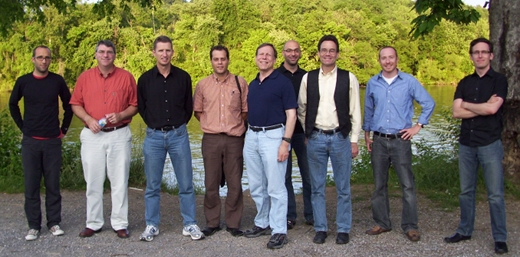| Description | Participants | Summaries | Products | Report | Feature |
|---|
Working Group: Biological Problems using Binary Matrices
 |
| Working Group members (L to R): Daniel B. Stouffer, Robert Dorazio, Richard Barker, Diego Vazquez, Steven Schwager, Stefano Allesina, Nicholas Gotelli, Joshua Ladau, Steven Kembel; (Not Pictured): Jennifer Dunne, Dan Simberloff, Edward Connor. |
Tackling a Math Problem for Ecology
May 19, 2009
 |
| Many ecological data can be summarized in binary matrices, for instance the distribution of aquatic organisms in lakes in the Sierra Nevada Mountains (above). A major goal of the Binary Matrices NIMBioS Working Group is to develop improved methods for inferring large-scale effects of ecological mechanisms from this type of data. |
For years, ecologists have struggled to answer some fundamental questions in ecology using certain statistical tests. Trying to measure the distribution of a species over time or geographical space, for example, poses a challenge, as does studying food webs and pollinator networks or investigating how ecological communities are comprised.
Because at large scales such questions often cannot be answered by conducting an experiment, they are explored by making inferences from observational data, specifically binary matrices.
Ecologists turn to a statistical method called null model testing to examine binary matrices. Yet, the null model testing of binary matrices has proved problematic.
In May, a team of biologists, statisticians, and mathematicians gathered at a meeting at the National Institute for Mathematical and Biological Synthesis (NIMBioS) in Knoxville, Tenn. to tackle the statistical issue and work toward developing a mathematical solution.
"The idea of using a mathematical framework for developing optimal methods is new," said Joshua Ladau, co-organizer of the NIMBioS Working Group and postdoctoral fellow at the Gladstone Institutes at the University of California San Francisco.
Ladau believes one of the chief problems of using null model tests is that they’ve been developed on the basis of intuition, which can lead to conflicting and unreliable results.
The goal of the NIMBioS working group is to develop an overarching mathematical framework that will guide the development and application of null model tests.
"We hope doing this work will help find answers to fundamental ecological questions," Ladau said. "One of the roadblocks to finding those answers is the shortcomings of the current methodologies."
Bringing researchers together from different disciplines will hopefully lead to new insights and in turn generate new ecological questions, Ladau said.
The National Institute for Mathematical and Biological Synthesis (NIMBioS) brings together researchers from around the world to collaborate across disciplinary boundaries to investigate solutions to basic and applied problems in the life sciences. NIMBioS is funded by the National Science Foundation in collaboration with the U.S. Department of Homeland Security and the U.S. Department of Agriculture, with additional support from The University of Tennessee, Knoxville.
For more information, contact Catherine Crawley at 865-974-9350 or ccrawley@nimbios.org
NIMBioS
1122 Volunteer Blvd., Suite 106
University of Tennessee
Knoxville,
TN 37996-3410
PH: (865) 974-9334
FAX: (865) 974-9461
Contact NIMBioS


